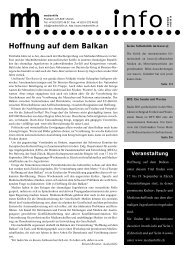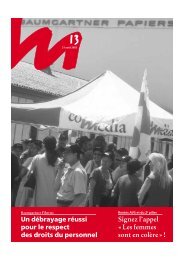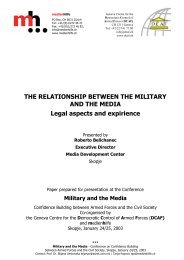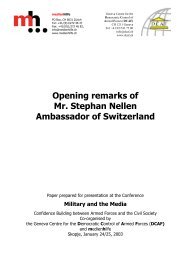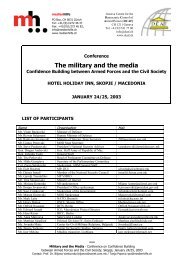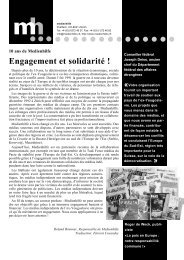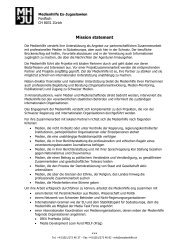THE FORMS OF INFORMATIVE INTERVENTIONS - medienhilfe
THE FORMS OF INFORMATIVE INTERVENTIONS - medienhilfe
THE FORMS OF INFORMATIVE INTERVENTIONS - medienhilfe
Create successful ePaper yourself
Turn your PDF publications into a flip-book with our unique Google optimized e-Paper software.
Geneva Centre for the<br />
Democratic Control of<br />
Armed Forces (DCAF)<br />
CH 1211 Geneva<br />
Tel. +41/22/741 77 00<br />
info@dcaf.ch<br />
www.dcaf.ch<br />
<strong>THE</strong> <strong>FORMS</strong> <strong>OF</strong><br />
<strong>INFORMATIVE</strong><br />
<strong>INTERVENTIONS</strong><br />
from Yugoslavia to the virtual<br />
wars of the 21 st century<br />
<strong>medienhilfe</strong><br />
PO Box, CH 8031 Zürich<br />
Tel: +41/(0)1/272 46 37<br />
Fax: +41/(0)1/272 46 82<br />
info@<strong>medienhilfe</strong>.ch<br />
www.<strong>medienhilfe</strong>.ch<br />
Presented by<br />
Nikolaos Dem.-Ang. Arvanites<br />
Researcher / Journalist<br />
Centre for Civil-Military<br />
Relations CCMR<br />
www.ccmr-bg.org<br />
office@ccmr-bg.org<br />
tel/fax: +381-11-435 428<br />
Paper prepared for presentation at the Conference<br />
Security Sector Reform and the Media<br />
Regional Conference on defence<br />
and the freedom of information<br />
Organized by<br />
Geneva Center for the Democratic Control of Armed Forces DCAF<br />
and <strong>medienhilfe</strong> Switzerland<br />
in cooperation with the Center for Civil-Military Relations CCMR<br />
Media Center Belgrade<br />
www.mediacenter.org.yu<br />
mc.mail@mediacenter.org.yu<br />
tel:+381-11-3343 225<br />
fax:+381-11-3343 420<br />
and the Media Center Belgrade<br />
Serbia & Montenegro, November 14/15, 2003
Nikolaos Dem.-Ang. Arvanites : The Forms of Informative Interventions - 2 -<br />
The Yugoslav crisis begins at the time when historical myths empirically unknown to us stylize<br />
with the help of the media into a national event with one part of the population clearly<br />
recognizing the other as the enemy. This means war is about to break out. There are wars in the<br />
geographical area of the Balkans waged over the territories and borders. They break out as the<br />
wars of symbols and words. It is only a Greek – Macedonian dispute over the name and the<br />
national flag of the former Yugoslav Republic of Macedonia that haven’t led to one more Balkan<br />
war.<br />
It is the Yugoslav crisis that paved the way for the wars of the future, especially the 1999<br />
clashes between NATO and the Federal Republic of Yugoslavia when NATO, a military and<br />
political alliance that became a media company with its PR management and information –<br />
making centers. Besides “humanitarian interventions” justified through general phrases on the<br />
protection of international piece, ethic relations and human rights, so called “informative<br />
interventions” are activated.<br />
“The informative interventions” can be defined as “the domination of political over professional<br />
journalism guidelines”. The informative interventions become the first and the last asset to<br />
“humanitarian interventions” for it is the public they initially spur, shape it in line with the goals of<br />
the military and political, chiefly intelligence powers of a country, and then, once the goal has<br />
been reached, they analyze and estimate the results predominantly hushing up all the bad and<br />
detrimental things flowing from the “humanitarian interventions” including war crimes, pollution,<br />
use of dangerous armaments and above all the destruction of state sovereignty, governments<br />
and political regimes, which are defined as the disturbing factor of world and regional safety.<br />
Reinforcing the strategic goals of the “informative and humanitarian interventions” is achieved by<br />
means of a global propaganda using all the permissible and unprofessional methods.<br />
Propaganda (of a known or unknown source) is used to strengthen a government’s attitude or<br />
intents in a move to act in military, humanitarian or preventive conditions. In that context we may<br />
speak of a few types of propagandas and psychological manipulations (aggressive and<br />
regressive). It is an organized activity, complex work on spreading certain ideas and<br />
understanding aimed at changing the different ideas, attitudes and understandings of an<br />
individual or nation.<br />
This is where PR agencies play an important role representing the interests of a subject of<br />
international relations and dealing with propaganda to the extent set. Today there are about a<br />
hundred agencies of the kind. Experts on media and crisis communication recognized in it an<br />
informative revolution and the art of «spin-doctoring» - a PR strategy giving news the desired<br />
direction of interpretation.<br />
***<br />
Security Sector Reform and the Media.<br />
Regional Conference on defence and the freedom of information - Belgrade, November 14/15, 2003
Nikolaos Dem.-Ang. Arvanites : The Forms of Informative Interventions - 3 -<br />
Speaking of former Yugoslav republics, the Slovenians had the most up-to-date equipment and<br />
perfectly organized their information headquarters into communes with more than 150 people<br />
working day and night.<br />
At the proposal of the Croatian Diaspora in America, Ruder & Finn, a Washington – based PR<br />
agency, was hired in Croatia for a $10,000 appanage a month, plus costs between August 1991<br />
to June 1992.<br />
Prior to war in BiH, the Bosnian lobby hired the two most powerful PR agencies: Hill and<br />
Knowlton and Ruder & Finn Global Public Affairs. A monthly appanage for planning certain<br />
activities of Ruder & Finn cost $18,000. Placing information independently depending on the<br />
effect was paid for every news. A campaign on death camps in Bosnia officially cost $480.000.<br />
Estimates show that the separatist movement in Kosmet annually earmarked up to 60 million<br />
convertible marks for its media presentation engaging some 150 of its journalists in Kosmet and<br />
over 100 journalists in the West. Support to extreme movements also comes from PR teams in<br />
the Albanian Diaspora, which form the public opinion in the West and are even backed by<br />
foreign governments as in the case of NAAC (NATIONAL ALBANIAN AMERICAN COUNCIL).<br />
The NAAC includes people like William Walker, other celebrities and diplomats.<br />
In that context, the Serbs, the people of Serbia and the citizens of the then Federal Republic of<br />
Yugoslavia were constantly sacrificed by a provincial regime of political improvisers 1 on the one<br />
hand and satanized by the enemy on the other hand. Not only did this have an effect on public,<br />
social and private lives but was also one of the leading cards to the creators of the informative<br />
intervention and propaganda war in these areas and a sore point of media activities.<br />
An information war is part of war dimensions. It is an offensive and defensive use of information<br />
and information systems aiming to use, bribe, ruin and destroy information and information<br />
systems of the enemy concurrently protecting personal information and systems. Researches<br />
differentiate three aspects in that war: to get information; to prevent someone else from reaching<br />
the information; to make others reach false information. This third aspect regards disinformation<br />
1 In the meantime, four powers were formed in the FR of Yugoslavia and the Republic of Srpska, which later on grow<br />
into mafia structures of pyramidal character closely connected with the same structures among Muslims, Croats and<br />
Albanians. In effort to permanently be in power in Serbia and Montenegro, Slobodan Milosevic allowed and<br />
succeeded to form an army of the hundred most influential members of economic, intellectual and security “elite”<br />
between 1991 and 2000 regardless of political and ideological affiliation. This oligarchic structure depended on the<br />
criminal underground to a great extent. An excuse for their actions and existence was the protection of national<br />
interests although they all found (not only Milosevic’s Party) alternative crisis suitable for it was the only way to<br />
preserve and camouflage the provincial regime of political improvisers. Clashes between Belgrade and the Bosnian<br />
Serbs were actually a clash between the political and criminal underground of two feudal lords, Karadzic and<br />
Milosevic, who, by giving the green light for ethnic cleansing in Krajina and a substantial reduction in the territory of<br />
the Bosnian Serb Republic, won the title of the “factor of stability and piece in the Balkans” according to Holbrooke.<br />
***<br />
Security Sector Reform and the Media.<br />
Regional Conference on defence and the freedom of information - Belgrade, November 14/15, 2003
Nikolaos Dem.-Ang. Arvanites : The Forms of Informative Interventions - 4 -<br />
and impact on opinion and attitudes. The importance of media and information war becomes the<br />
primary doctrine of the national defense of the 21 st century and its key argument. Information<br />
weapons in America’s military doctrine of the 21 st century are seen as the basic element of the<br />
so-called “doctrine of the targeted power”.<br />
It is this fact that has made disinformation a powerful weapon in activating the foreign policy of a<br />
country in crisis areas. And when the “real” information was scanty to achieve success,<br />
disinformation was used as a basic and strategic means of manipulation, a means of creating<br />
the public opinion or pressuring the centers of power to take action unjustified both legally and<br />
internationally. This is why psychological manipulations matter that much. They are placed<br />
through the media and they bring prestigious journalism awards, reputation and high fees. It is<br />
the secret operations budget of powerful intelligence systems that often covers the costs.<br />
During “special operations” secret services use strategic disinformation and a wide range of<br />
world information obtained through a global network, the Esalon system. Much information and<br />
a number of analyses during the Cold War were obtained by the secret services through a<br />
network of agents, intelligent officers and associates working in the field through an “in-depth”<br />
analysis. The last decade of the 20 th century gave the powerful a chance to benefit from a<br />
sophisticated technology thus reducing the fieldwork. This appeared to be an obvious weakness<br />
in the Balkans in the fight against global terrorism and war in Iraq and Afghanistan.<br />
For the governments and their own promotion, the secret services created the world’s<br />
information war, which is today governed by them. Among the activities they are in charge of is<br />
also the “making” of an event and information or “creative disinformation”. Once the most<br />
important part of the police, today all kinds of intelligent officers are just a service for skilled<br />
experts on psychological war produce information on their own. The information must be as<br />
truthful as to have at least one “word” of ours in the entire text. Everything else is the truth that<br />
can be checked. Ninety-five percent of the truth has the best effect, i.e. five percent of lies in a<br />
text. The secret services create information that contains less 50% of the truth. This is made for<br />
the first reaction or “ a preventive attack” that creates the public opinion and stimulates a country<br />
and politics to react.<br />
How can we then define the role of the governments and secret services in an attempt to<br />
globally define “the information – informative order” in the world, particularly in the areas critical<br />
to the national interests of powerful states rather than tactical, operative and conceptual.<br />
• tactically – disorganizes the governing of a state or some parts of its vital activity<br />
• operatively – forcing the government to take inappropriate decisions<br />
• strategically - freezing the information and intellectual resources of a country<br />
• conceptually – disorientation and paralysis of the social awareness<br />
***<br />
Security Sector Reform and the Media.<br />
Regional Conference on defence and the freedom of information - Belgrade, November 14/15, 2003
Nikolaos Dem.-Ang. Arvanites : The Forms of Informative Interventions - 5 -<br />
Special strength to such a network of power – the power of the governments – secret services –<br />
military management, is fueled by the media and journalists that become “virtual” or “civil”<br />
solders doing the job with their laptops, satellite phones and cameras as part of the military<br />
machinery. Seeing that over 150 wars have been waged since 1945, it is clear that the role of<br />
journalism is not only a business but also a national and security mechanism. It can therefore be<br />
stated that “War is probably the most efficient machine used to wash and recycle carriers and<br />
businesses”. There are “Don Quixote” journalists trying to resist the power of a state and its<br />
intelligence machinery, but the number is, in essence, irrelevantly small. It is important to bear in<br />
mind that during the past twelve years, 1,192 journalists and media workers have been killed, 80<br />
of whom died during the Balkan conflict since the start of the breakup of former Yugoslavia in<br />
1991.<br />
News and information are trade above all, while ethics is in the background. Business is brisk in<br />
war-hit areas. The sale of media contents – news especially about crisis events during the past<br />
decade of the 20 th century became quite a profitable venture. Some information and media<br />
contents shaped into news for media campaigns and the governments of the countries taking<br />
part in the clashes cost a lot for they affected the governments’ decisions and “special<br />
operations” of the secret services which were cashing in on information in the news or electronic<br />
media to perform their preventive operations“ or “humanitarian interventions”.<br />
News about war was the most popular. It was both in favor of military cabinets and secret<br />
services. It triggered the preventive policies of the countries interested in the Balkans clashes.<br />
On the other hand, selective information, i.e. disinformation sold dearly. The information was a<br />
media response to the intents of the “underground diplomacy” and the military industry.<br />
A question is raised about relations between espionage and journalism. The relations between<br />
espionage and journalism remind of the game “man don’t get angry”, which makes you come full<br />
circle when someone reveals a discovery or news. The circle is totally perverted. The discovery<br />
can come from any of intelligence officers but just when the unchecked rumor is published, it<br />
becomes “news”. If the news draws politicians’ attention, it causes polemics meaning that the<br />
turmoil has already begun. Modern systems of espionage and information control raise the<br />
question of the depth of the governments’ and secret services’ activities aimed at controlling the<br />
informative and information field.<br />
Campaign: aimed at the Serbian side during the war in Bosnia and Herzegovina has a couple of<br />
various phases:<br />
‣ The theme for the first phase is “barbaric annihilation of civilians and objects by<br />
“aggressive” Serbian forces. Culmination of reports on this subject was the incident on<br />
Vase Miskina Street. This event directly lead to the implementation of sanctions against<br />
the Serbian Republic (SRJ) on May 29 th , 1992.<br />
***<br />
Security Sector Reform and the Media.<br />
Regional Conference on defence and the freedom of information - Belgrade, November 14/15, 2003
Nikolaos Dem.-Ang. Arvanites : The Forms of Informative Interventions - 6 -<br />
‣ The second phase consists of stories about Serbian “concentration camps”. Parallel was<br />
drawn with the Nazi concentration camps.<br />
‣ Third phase includes stories as well as “ testimonies from a large number of Muslim<br />
women who were raped and placed in special camps for sexual abuse”<br />
‣ In the forth phase a verdict was passed against the Serbs for “ethnical cleansing”<br />
against the Muslims within the “occupied territories”<br />
‣ The fifth phase was represented as “agonized” cities with mostly Muslims which were<br />
besieged; the message passed was “In the name of God do something”.<br />
‣ In the sixth phase “reports on executions of Muslim prisoners and the search for mass<br />
graves are most dominant. However during the whole time there were stories with other<br />
themes as well.<br />
During the crisis in Yugoslavia the media, instead of trying to direct public opinion toward peace<br />
with their reports or offer confirmed information they did their best in increasing prejudices<br />
especially when they forgot that all conceivable crimes, which occurred on all sides, should be<br />
individualized and not generalized.<br />
The Canadian General Louis McKenzie, the first commander of the UN Peace Force in Bosnia<br />
and Herzegovina, stated in June of ’92: The war in Bosnia and Herzegovina would have long<br />
been over if the Muslim leaders would stop killing their own people for the sake of CNN. There<br />
are still suspicions that the massacre which took place on Vase Miskina Street was the<br />
beginning of one type of “Muslim auto-terrorism” whose goal was to reach out and touch the<br />
international public as well as punish the Serbs with military intervention, as had occurred in the<br />
end. All this was done in a timely manner, so as to destroy the peace talks in Lisbon.<br />
The explosion which occurred on the Sarajevo market Markale on 5/2/1994 when 68 people<br />
died and 197 were wounded, as well as the explosion in Trgovacka St. in Sarajevo on 28/8/1995<br />
when 37 people lost their lives and 85 wounded were provoked by the Muslims and were aimed<br />
at evoking anger within the international community toward the Serbian people, in addition they<br />
needed to justify the bombing which took place on two occasions: on April 10/11 th in 1994 near<br />
Gorazde and in August of ’95. At the same time, the Croatian offensive was initiated in the<br />
western part of the Serbian Republic- at the Bosnian border.<br />
The stories about the raped Muslim women were timed so that they appeared prior to the<br />
Edinburgh summit which took place on December 11 th , 1992. It all started with rumors, and<br />
continued with official reports regarding the 20 -60 thousand Muslim women who were raped by<br />
Serbs. In the end, the UN committee found that 2, 400 women were victims of rape in Bosnia<br />
and Herzegovina and that they belonged to all three ethnic groups (Serbs, Muslims and Croats),<br />
based on 119 reported incidents, while the UN Security Council questioned 223 victims who<br />
recalled 4, 500 rape incidents, also from all three ethnic groups.<br />
International media simply ignored the photographs of mujahidin found in Jasenovi on the Crni<br />
Vrh, in September of 1992, which showed Serbian soldiers with their heads cut off. Almost<br />
***<br />
Security Sector Reform and the Media.<br />
Regional Conference on defence and the freedom of information - Belgrade, November 14/15, 2003
Nikolaos Dem.-Ang. Arvanites : The Forms of Informative Interventions - 7 -<br />
everyone was trying to minimize the effect of Islamizing in Bosnia and maximizing the “crimes<br />
committed by the Serbia aggressors”. It is true that during the war in Bosnia and Herzegovina<br />
618 mosques were completely destroyed of which many were of priceless historic, architectural<br />
and artistic value, but no one ever published a photo of the remains of Saborna Church in<br />
Mostar. A magnificent church, which loomed over the city, was leveled to the ground in the<br />
spring of 1992. The world also kept quiet about the Zitomistic Monastary, and all the other<br />
sacred Serbian buildings throughout the former Yugoslavia, including Krka, Krupa, Zocista<br />
Monastery and the medieval places of worship which were under the protection of UNESCO.<br />
The total number of destroyed buildings in the Bosnia & Herzegovina and Croatia includes 333,<br />
plus another 474 churches and Monasteries which were damaged. A comparison can be made<br />
with Kosovo, where 200 mosques (from the 607 which existed) were destroyed during the<br />
Kosovo Crisis and especially during the bombing which took place in Kosovo, yet since the<br />
arrival of KFOR in that region there have been 107 Serbian orthodox churches destroyed and<br />
damaged.<br />
The stories about concentration camps in which Serbs held Muslims captive (in locations such<br />
as Banja Luka, Cepljine, Foce, Bijelins, Brcko, Bosanska Gradiska) were initiated by the US<br />
newspapers led by the New York Times and their key interest was, as confirmed by the<br />
agencies chiefs Rudder and Finn, to win favor of the powerful Jewish lobby. Simultaneously at<br />
the margins of the international press there was information published about 394 concentration<br />
camps and jails which existed in 181 locations in Bosnia and Herzegovina where Serbs were<br />
being held captive. When mentioning Sarajevo no one mentioned that there were approximately<br />
12 000 Serbian victims which means that 7.6% of the Serbian population in Sarajevo lost their<br />
lives, while 150 000 fled from this city, and another 50 000 were jailed. The same goes for 1,<br />
500 missing Serbs, Muslims, Goranacs, Gypsies and other citizens for which it is assumed that<br />
695 of that are in concentration camps and jails located in Albania, Macedonia and Kosovo.<br />
There is no controversy over the fact that when Srebrenica the captured soldiers who were<br />
members of the Muslim Eight operative group, who committed great atrocities against the<br />
Serbian people since the war broke out in eastern Bosnia, but there was no genocide or<br />
systematic killings of the enemy. Srebrenica was the turning point of the war in Bosnia, because<br />
that was a media event. There were no journalists on the spot. Hundreds of them ran off to near<br />
by Tuzla, where they interviewed and taped the Srebrenica refugees. The 2 082 corpses, which<br />
have been up until now exhumed and found, under the care of the Hag tribunal investigators, is<br />
constantly being tripled, so that despite all the evidence it is being quoted as 7 333 missing.<br />
Today many other questions remain open: Why is it kept quiet that in the war of 1995, 500<br />
Serbs died during the breach of the 28 Muslim Division. Why do non profit organizations which<br />
are responsible for humanitarian rights not mention the 1 260 Serb civilians which lost their lives<br />
***<br />
Security Sector Reform and the Media.<br />
Regional Conference on defence and the freedom of information - Belgrade, November 14/15, 2003
Nikolaos Dem.-Ang. Arvanites : The Forms of Informative Interventions - 8 -<br />
to the Naser Oric squadrom from Srebrenica. Is it true that, as evidence shows Srebrenica was<br />
consciously sacrificed by the Muslims but maximally used by the media?<br />
In the next phase of the Yugoslav Crisis, during the time that the “Kosovo issue” was being<br />
resolved the media might have had an opportunity to play their real role and add light to the<br />
situation. However we all found ourselves (Serbians and Albanians alike) in a mosaic of<br />
misunderstandings: on the one hand the fact that the Balkan actors are not offering their<br />
definition of national interest, nor a projection of realistic and effective multilateral approach,<br />
instead of that they are repeating the folkloristic stereotype, and on the other the fact that the<br />
observers from the outside are not familiar with the micro encirclement. Both sides, the Serbian<br />
and Albanian, were successful in creating a wall of self-imposed isolation considering that they<br />
are insisting on selfish macro dimensional presentation instead of micro-dimensional analysis,<br />
so that questions without answers go in favor of outside forces and third parties which plan to<br />
intervene as “mediators” instead of rationally creating mutual trust and understanding.<br />
In all tense situations in Kosovo, it was difficult and almost impossible to create a clear<br />
difference between criminal and political activities. It turned out the most energy was invested<br />
into propaganda against the OVK and the Albanian movement which contributed to the increase<br />
in their popularity. The impression is given that the Serbian propaganda has most contributed to<br />
lifting the veil of secrecy over the OVK and its development into a public political factor, not only<br />
so in Kosovo. Quite likely it is this that was the deciding factor in popularizing the OVK among<br />
the Kosovo Albanians. OVK was not even mentioned in the Albanian media, so the Serbian<br />
propaganda achieved an adverse effect.<br />
The fact that the radicalization of the Kosovo situation was wished for by the radical Islamic<br />
movement was hidden, evident in the incident at North Kavkaza in Russia, where the<br />
government was trying to eliminate Vahabits and their movement which was aiming to move<br />
their center of activities to North Albania and Kosovo. Starting then the Saudi Arab circles have<br />
supported the OVK, some individuals were given the right to support the OVK financially, and<br />
the Islam extremists where able to take part in military activities of the organization.<br />
The Serbian side was completely blocked by a disreputable oligarch scared off by someone on<br />
the outside, which used the Kosovo issue to protect their authority by improvising and repeating<br />
the same questions from the period of the Bosnian crisis. The media war against Serbia<br />
including the tolerance of the separatist terrorism was developed through the same media<br />
models and stereotypes as in Bosnia and Herzegovina and Croatia:<br />
‣ Development of theory that Serbia “ethnically cleansing” and the plan “Big Serbia” right<br />
on its own territory<br />
‣ Yugoslav Military and Ministry of Internal Affairs are held responsible, which in turn<br />
makes the Republic of Serbia’s’ sovereignty questionable<br />
***<br />
Security Sector Reform and the Media.<br />
Regional Conference on defence and the freedom of information - Belgrade, November 14/15, 2003
Nikolaos Dem.-Ang. Arvanites : The Forms of Informative Interventions - 9 -<br />
‣ In the media, as “Srebrenica incident” was used so were “Drenica incident” and “Racak<br />
incident”. Until it fell, Srebrenica was an important Islam bastion and information base for<br />
the US. Drenica is the central base for the separatist terrorism and Racak one of the<br />
UCK centers. With use of Drenica, the myth about UCK was created, and if it wasn’t for<br />
Racak, the air campaign against Yugoslavia would have never taken place<br />
‣ Scenes were created of the “exodus” of the Albanins, who left their villages under the<br />
pressure of the UCK terrorists, as did Serbs because of fear and reprisal<br />
During the aggression on Yugoslavia. The NATO forces influenced all media centers and they<br />
were aiming toward two goals: Elimination of the possibility of the Yugoslav public being<br />
informed, which would cause an increase in their feelings of insecurity and panic, as well as<br />
opening up the possibility of propagandist influence of the aggressor forces through their own<br />
information sources.<br />
The end of journalism and objective crisis reporting. This did not only happen during the<br />
Yugoslav crisis, for on April 23 rd , 1999 at 2:06 am NATO forced attacked 16 employees of the<br />
Radio-Television Serbia media center. Our colleagues were written off and sacrificed political<br />
subjects in Belgrade, executed by NATO. Those who ordered the bombing and those who did<br />
nothing to protect their employees are to blame. At the sound of the air raid alarm all were to be<br />
hidden, yet in that building there was no bomb shelter. After all no one was hurt when the Novi<br />
Sad Television building was leveled to the ground.<br />
Strategy of the “new informative-informational and media system”, talks more and more about<br />
virtual journalism, virtual wars, virtual defense, virtual rivals and virtual cyber criminal and<br />
terrorism which noticeably rocking the national strategy of powerful countries through a<br />
“background” war by disturbing strategic systems which are based on the global network and<br />
superb information systems. The Western rivals have created a new type of special war which<br />
was continued with the terrorist influence of AL KAIDA who has confirmed the existence of<br />
mega-terrorism with the use of the virtual network as the AL KAIADA database and new media<br />
networks which have replaced CNN as the AL DZAZIR TV station.<br />
One less familiar fact regarding the Kosovo crisis and the so called Albanian cyber terrorism is<br />
that the Albanians had 1,500 sites on the internet (and they have more related to ANA), of which<br />
most were masked by electronic stations of various humanitarian organizations, which are<br />
followed by the Arab and Islamic population. Basically there were three databases used for the<br />
Albanian cyber terrorism, one in Kosovo, another in the US and the last in Germany. In the<br />
beginning the most popular site was the UCK from Croatia. In addition to the 1,500 Albanian<br />
sites there are at least 10 times more internet substations in support of them. Therefore the<br />
Albanian terrorists had at least 15, 000 sites for propaganda of their ideas of political violence.<br />
The Americans and Europeans refer to Albanian terrorism on the Internet as hackerism, which<br />
minimizes the danger from OVK and their successors, ANA and ONA. The reason for the<br />
***<br />
Security Sector Reform and the Media.<br />
Regional Conference on defence and the freedom of information - Belgrade, November 14/15, 2003
Nikolaos Dem.-Ang. Arvanites : The Forms of Informative Interventions - 10 -<br />
tolerance toward sites with terrorist messages ANA, is the close collaboration between some<br />
western countries and their secret agencies with Albanian terrorists. They use ANA for<br />
destabilization of the Balkans and Southern Europe.<br />
An interesting fact is that similar methods were used and are still being used by terrorists from<br />
the Chechnya separatist movement whose internet’s websites are being inter-connected and<br />
are functionals throughout various links. Instantly there are 20 active sites. Almost each chechen<br />
leaders has his personal website such as are Alsan Mashadov, Movladi Udugov, Jandarbijev,<br />
Ahmadov and available is also the internet address of the so called “Ministry of the Foreign<br />
Affairs of Ickeria”. The most active and popular web site in Europe is KAVKAZ CENTAR. The<br />
most known “chechen cyber-terrorist” in western Europe is Sajid- Magomed Hacukajev.<br />
In accordance with the decision of the Association for coordination of foreign policy in Lithuania,<br />
whose country president is Roland Picks, the Chechnya separatist internet site KAVKAZ-<br />
CENTER was closed down. At the press conference the Lithuania POCJ counterintelligence<br />
representative announced that the site was linked to propaganda of terrorism and promoting<br />
national differences. Considering that the international terrorists and their leader Osama Bin<br />
Laden finance various numbers of informational programs and projects, analysts believe that<br />
parts of these resources were on the bank accounts of the KAVKAZ-CENTER.<br />
It is obvious that the future of the representative of the “7 th force” in crisis and war situations are<br />
between a soldier and a private eye in other words between a “secret” warrior who across the<br />
global network and “hacking” system create information within the boundaries of “informativemedia-intervention”<br />
and “virtual-real war”. Journalists are more often becoming “virtual”<br />
commentators, informers or cameramen who use new informational technologies and<br />
capabilities. It is in this context which raises the question for future conflict-wars, media and the<br />
role of journalists as well as those who work on prevention and those who lead the information<br />
war with visible consequences. There is an increase in modern journalists and analysts who sit<br />
in front of their powerful computers and programs, and are in a position to create media content<br />
required for crisis situation. Furthermore this raises a question whether the wars of the 21 st<br />
century are initiated in cyber space at the border between information and politics. If the<br />
opponents target is related to information technology and info structure and the only weapon is a<br />
computer virus no one will know that the war will continue until it’s over. This type of war will<br />
represent a challenge for persistence and media attention. Future wars will be completely<br />
unnoticed by journalists and bystanders.<br />
In every war the first sacrifice is the truth, but in a virtual war the media creates an illusion that<br />
what we are seeing is the truth.<br />
***<br />
Security Sector Reform and the Media.<br />
Regional Conference on defence and the freedom of information - Belgrade, November 14/15, 2003
Nikolaos Dem.-Ang. Arvanites : The Forms of Informative Interventions - 11 -<br />
Books and Articles<br />
1. Altafaj Amadaeu- Segovia Carlos, PRVI PLAN: Nato u jednom dokumentu priznao da gubi<br />
informativni rat, www.arhiva.inet.co.yu (original in www.elmundo.es/1999/05/31/europa/31n0006.html)<br />
2. Arvanites N.D.A., Geopolitika I Balkan, Balkansko Udruzenje za Krivicno Pravo, Beograd, 2000<br />
3. Arvanites N.D.A., Balkanski Čvor-Balkan Knot, Andainfo, Beograd, februar 2002<br />
4. Arvanites N.D.A., Sigurnosna Dimenzija, AndaInfo, Beograd, avgust 2002<br />
5. Arvanites N.D.A., Geo-Izborna Dimenzija, Anda Info, Beograd , februar 2003<br />
6. Beham Mira, Ratni Dobosi:1991-1995, Glas Javnosti, 21/1-11/2/2002<br />
7. Berkowitz Bruce D., Information Age Intelligence,Foreign Policy, Summer, 1996<br />
8. BINA NEWS AGENCY, The Media Happened to be There, Beograd, 1994<br />
9. Blanford, N. (2001). 'Hizbullah Steps up Psychological Warfare: Party believes that the Media<br />
Plays Critical Role in Palestinian Uprising.' Daily Star (Beirut) 8 September. Available online at<br />
http://www.hizbollah.org/english/press/p2001/p20010908a.htm.<br />
10. Blazanovic Jovo, Precutani Zlocini, Banja Luka, 2003<br />
11. Conway, M. (2002). 'Reality Bytes: Cyberterrorism and Terrorist "Use" of the Internet', First<br />
Monday 7(11). Available on the Internet at<br />
http://www.firstmonday.org/issues/issue7_11/conway/index.html.<br />
12. Crelinsten, R.D. (1987). 'Power and Meaning: Terrorism as a Struggle Over Access to the<br />
Communication Structure.' In P. Wilkinson & A.M. Stewart (Eds.), Contemporary Research on<br />
Terrorism. Aberdeen: Aberdeen University Press.<br />
13. Campbell K.K., Serbian War Moves to Cyberspace, The Toronto Star, April 1999<br />
14. Damnjanovic M., Rat na Internetu, NIN, 6/3/2003, broj 2723<br />
15. Denning, D. (2001a). Is Cyber Terror Next? New York: US Social Science Research Council.<br />
Available online at http://www.ssrc.org/sept11/essays/denning.htm.<br />
16. Denning, D. (2001b). 'Hacker Warriors: Rebels, Freedom Fighters, and Terrorists Turn to<br />
Cyberspace', Harvard International Review, Summer. Available online at:<br />
http://www.hir.harvard.edu/archive/articles/pdf/denning.html.<br />
17. Dunn Myriam A., The Cyberspace Dimension in Armed Conflict: How the Internet Changes the<br />
Face of War, Information and Security, Volume 7, June 2001, pp 145-158<br />
18. Flynt Bill, Threat Convergence, Military Review, September-October 1999<br />
19. Harf Yems, Slavili smo bombardovanje Beograda, NIN, 4/9/2003, Broj 2749<br />
20. Ignjatijef Majkl, Virtuleni Rat, Samizdat B92, Beograd 1999<br />
21. Isakovic Zlatko, Uvod u Propagandu, Zavod Za Udzbenike I Nastavna Sredstva, Beograd, 1991<br />
22. Ilic Vladimir, Familija: Medijski Poredak Novog Sveta, KONRAS, Beograd, 2002<br />
23. Krasavin Serge, What is Cyber-Terrorism, CCRC, www.crime-research.com<br />
24. Kresovic Tomislav, Velike Igre na Balkanu, Grafikom, 1999<br />
25. Marsal Tim, Igra Senki, Samizdat B92, Beograd, 2002<br />
26. Memorandum o Kosovu i Metohiji, SPC,Beograd 2003<br />
27. Messmer Ellen, Kosovo Cyber-War Intensifies, Enterprise Networks: Now Chinese hackers target<br />
US sites, government says,Network World Fusion, 12/5/99<br />
28. Metzl Jamie, F.,Information Intervention: When Swithing Channels Isn't Enough, Foreign Affairs,<br />
November/December 1997<br />
29. Milivojevic Cvijetin, Globalno Potemkinovo Selo, Beograd 1996<br />
30. Pahlavi Pierre, C.,Cyber-Diplomacy: A New Strategy of Influence, McGill University, May 2003<br />
31. Pirocanac-Petrovic Zoran, "The Lessons of Yugoslavia": The Role of the Press in the Yugoslav<br />
Crisis, paper presented at the Innis College, Toronto, Ontario, 21/3/1997<br />
32. Poter Evan, H., Cyber-Diplomacy:Managing Foreign POlicy in the Twenty-First Century, McGill-<br />
Queen's University Press, 2002<br />
33. Price Monroe E., Journeys in Media Space, Global Media and National Controls:Rethinking the<br />
Role of the State, 2001<br />
34. Radosavljevic Vladan, Pistaljke i Jaja, Medija Centar, Beograd, 1997<br />
35. REPUBLIKA, Novinarstvo Juce i Danas, broj172<br />
36. Remondino Enio, Televizija ide u Rat, CLIO, Beograd, 2002<br />
37. Reljic Dusan, Pisanje Smrti: Mediji u Vremenima Sukoba, Radio B92, Beograd, 1998<br />
38. Sicherman Harvey, The Revival of Geopolitics, The InterCollegiate Review, Spring 2002<br />
39. Tadic Milan, Osnovi Medjunarodne Propagande, BINA, Beograd, 2002<br />
40. Volkov Vladimir, Dezinformacija:od Trojanskog Konja do Interneta, Nas Dom, Beograd, 2002<br />
***<br />
Security Sector Reform and the Media.<br />
Regional Conference on defence and the freedom of information - Belgrade, November 14/15, 2003
Nikolaos Dem.-Ang. Arvanites : The Forms of Informative Interventions - 12 -<br />
41. Vujovic Miso, Masakriranje Istine, Podgorica-Nova Pazova, 2003<br />
42. Center for Strategic and International Studies<br />
43. Washington DC http://www.csis.org<br />
44. Cyber Terrorism Resource Centre Provides to links to article and commentaries around the world.<br />
http:// www. globaldisaster. org/ cyberterrorrescen.shtml<br />
45. Internet / Network Security Resource guide on Cyberterrorism<br />
46. Nune Alfred, Internet and Albania: A paradoxical Ambivalence?, http://soemz.euv-frankfurto.de/media-see/<br />
newmedia/ main/ articles/a_nune.h tm# intro<br />
47. IFJ, Vesti Uzivo, Medjunarodna Federacija Novinara,Beograd Mart, 2003<br />
Websites and Internet Articles<br />
48. http://netsecurity.about.com/cs/cyberterrorism/<br />
49. IWS United Kingdom Website Listing , http://www.iwar.org.uk/ cyberterror/index.htm<br />
50. sgluck176@aol.com, Documents, Reports, and Commentary on the Politics of the War Against<br />
Yugoslavia, June, 1999<br />
51. National Cyber Security Alliance http://www.staysafeonline.info/<br />
52. Terrorism Questions and Answers : Cyberterrorism Council on Foreign relations<br />
http://www.terrorismanswers.com/terrorism/cyberterrorism.html<br />
53. Terrorism questions and answers: Cyberterrorism Europe Council on Foreign relations<br />
http://www.terrorismanswers.com/coalition/europe.html<br />
54. UK: technology news reviews and downloads http:// www. vnunet. com/ News/ Security<br />
55. PRESS HOME NOW, Wiring Up Kosovo http://<br />
www.xs4all.nl/~pressnow/media/kosovo/991005.html#article<br />
56. CARNEGIE ENDOWMENT FOR INTERNATIONAL PEACE, Lecture Series: Winning Hearts and<br />
Minds: Propaganda and Public Diplomacy in the Information Age, November 2001, www.ceip.org<br />
57. Logori Smrti, http://dzemat.tripod.com<br />
58. Albanian National Army, www. aksh.org<br />
59. Chechynian web sites: www.chechenpress.com, www.kavkazcenter.com, www.chechnymfa.info.,<br />
www.kavkazcenter.info<br />
Disclaimer: Conference Papers<br />
Conference Papers constitute studies designed to promote reflection and discussion on civil-military<br />
relations and issues of democratic control over defence and security sector. The publication of these<br />
documents is unedited and unreviewed.<br />
The views and opinions expressed are those of the author(s) and do not necessarily reflect those of<br />
the organizers.<br />
Conference Papers are not for quotation without permission from the author(s) and the organizers.<br />
***<br />
Security Sector Reform and the Media.<br />
Regional Conference on defence and the freedom of information - Belgrade, November 14/15, 2003



